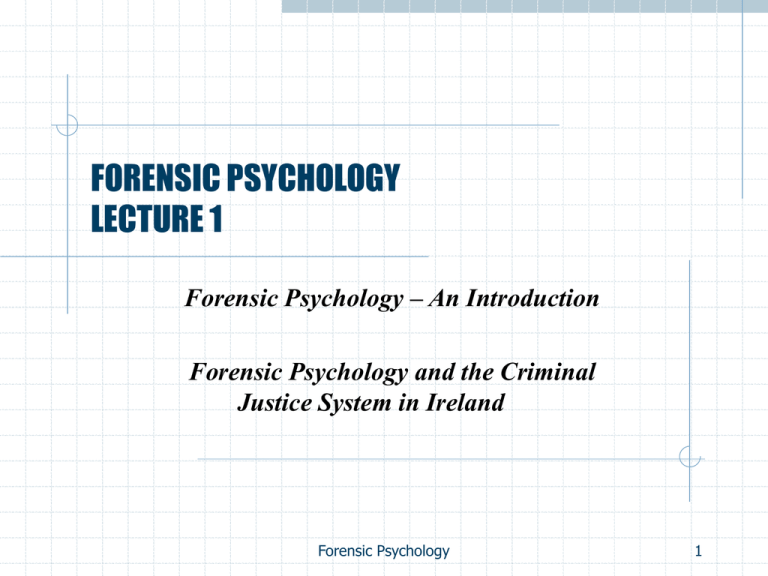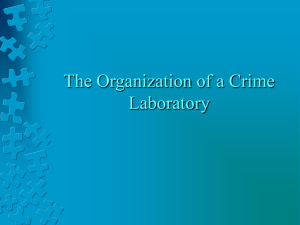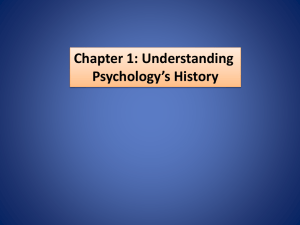
FORENSIC PSYCHOLOGY
LECTURE 1
Forensic Psychology – An Introduction
Forensic Psychology and the Criminal
Justice System in Ireland
Forensic Psychology
1
Recommended Reading
Howitt, Dennis. (2009), Introduction to Forensic and Criminal
Psychology: 3rd Edition. London: Pearson Prentice Hall – Chapter 1, 2 & 3.
O' Mahony, M. (1997), Mountjoy Prisoners: A Sociological and
Criminological Profile. Government Publications.
Hollin, C.R. (1989), Psychology and Crime: An Introduction to
Criminological Psychology. London: Falmer Press.
Hollin, C.R. (1992), Criminal Behaviour: A Psychological Approach to
Explanation and Prevention. London: Falmer Press.
O' Mahony, P. (1995), Crime and Punishment in Ireland. Round Hall
Sweet and Maxwell. Chapters 4 & 5
Forensic Psychology
2
Aims of Lecture
Understand the alliance between psychology and law.
Describe forensic psychology and criminal psychology and
where forensic psychologists are employed.
Explain the difficulties with defining “crime” and describe the
various views on defining crime.
Examine some of the issues associated with the criminal justice
system in Ireland.
Gain an insight into the background of an Irish “prisoner”.
Forensic Psychology
3
Psychology and Law
Carson & Bull (1995) – “At the heart of law and psychology lies a
conundrum”
Howitt (2009) – “The relationship between psychology and the law has not
always been an easy one” – Legaland and Mentaland
Although very different disciplines, psychology is bound in law and the legal
system.
Commonalities exist between psychology and law - Both have human
nature for their subject matter…both try to understand and predict human
behaviour…both focus on the individual, although their behaviour might be
shaped by others.
The law has the assumption that people operate as a result of free will, and
sets out to make the individual responsible for their actions.
Psychology is directed towards an explanation or prediction of the factors
determining behaviour (biological, psychological, environmental).
Forensic Psychology
4
Forensic Psychology – An Introduction
Criminal Psychology is the study of criminal behaviour (Howitt, 2009).
The term “forensic” is generally used to refer to psychologists who work
with offenders, and/or victims of crime. Forensic psychology is
concerned with the application of psychological principles within the
judicial system, as it examines the interface between criminal justice and
psychology.
Wrightsman (2001) regards forensic psychology as “any application of
psychological knowledge or methods to a task faced by the legal system”.
The focus of this course places an emphasis on the practical application
of psychological theory in a forensic environment. The course aims to
train students to apply psychological insights, concepts and skills to the
understanding and functioning of the legal and criminal justice system.
Forensic Psychology
5
Roles of the Forensic Psychologist
Haward (1981) – Forensic Psychology – roles of psychologists in criminal
proceedings include clinical, experimental, actuarial and advisory roles.
Clinical Role – Clinical interviewing, psychological assessments/evaluations,
question of psychological disorder, psychometric testing, etc.
Experimental Role – Experiments for the defence/prosecution –eye witness
testimony.
Actuarial Role – Statistical probabilities to behavioural data.
Probabilistic
reasoning. The incidence of a given human event in an appropriate sample of the
population, i.e. young male drivers.
Advisory Role – Examining the evidence of other experts.
Advice to
defence/prosecution. Investigative psychology.
Forensic Psychology
6
What does a Forensic Psychologist do?
Forensic Psychologists are involved
in
the
practical
application
of
psychology in forensic environments
They generally work with offenders
and/or victims of crime
Where? – Prisons, hospitals, law
enforcement settings, court.
Who?
– Juvenile offenders,
paedophiles,
spousal
abusers,
psychopaths, terrorists, those suffering
from
mental
disorder,
homicidal
offenders, stalkers, sex offenders, etc.
Tasks include:
Eyewitness testimony.
Clinical interviews.
Psychological tests.
Forensic profiling.
Risk Assessments.
Treatment – i.e. cognitive
behavioural programmes, therapy, etc.
Academia and research
Jury selection.
Liaison with those that are involved
in the criminal justice system –
offenders, police, legal profession,
courts, prisons, probation and welfare
service,
victim
support,
NGO’s,
criminologists,
social
workers,
hospitals.
Forensic Psychology
7
Crime
Crime is a term that is relative and culturally defined – although it exists
among all social classes, both the type of crime committed and the extent
to which the law is enforced vary, i.e. t is punished.
No single definition exists - Various definitions –influenced by public
opinion.
• An act punishable by law (English Dictionary)
• An act, which is harmful to social well-being and is judged to be deserving
of public attention through the application
• Criminal behaviour is an act that violates
be followed by criminal proceedings
punishment. (Hollin, 1999)
• Anything forbidden or punishable by
(Feldman, 1993)
Forensic Psychology
of State power (Giddens).
criminal law and may therefore
and attracts the appropriate
the criminal justice system.
8
Defining Crime - Hollin (1999)
The Consensus View
Functionalist perspective from sociological research. The idea of society
functioning as the member respects a whole, and norms, rules and
values because of consensus or agreement’s of that society. The
majority in that society meets a crime with disapproval.
Forensic Psychology
9
Defining Crime - Hollin (1999)
The Conflict View
Opposed to the Consensus view. Argues that society operates as a
collection of competing diverse groups, rather than a unified whole.
Unequal distribution of wealth and power. This conflict promotes crime
- Marxist theory.
Forensic Psychology
10
Defining Crime - Hollin (1999)
The Internationalist View
The Interactionalist view lies between the consensus view and the
conflict view. It began with “symbolic internationalism” (Blumer, 1969)
and focuses on meaning. The behaviour of an individual is guided by
their interpretation of reality and the meaning events have for them.
The meaning is learned from the way other people react, (positive or
negative) towards any given person or situation. Therefore, one’s
behaviour is made according to the meanings learned and acquired
from others.
Forensic Psychology
11
Criminal Justice System
•
•
•
•
•
•
•
The criminal justice system is complex, but in essence, promotes law
abiding behaviour and discourages law-breaking behaviour. There are
many components to and issues associated with the criminal justice
system, i.e.
Types of crime – murder, rape, theft, fraud, public order, etc.
Recording and classification of crime
Crime prevention,
Imprisonment
Penal policy
Sentencing
Case law decisions, etc
Forensic Psychology
12
Criminal Justice System
• Feldman (1993) – four components of the criminal justice system
Offences, Offenders, the Police and the Courts.
• Irish context - The offence, the offender, the police, the courts, the
probation and welfare service, the prison service and the Department of
Justice.
• Chief State Solicitor, Director of Prosecutions, An Garda Síochána.
Forensic Psychology
13
Crime and Mental Illness
M’Naghten Rules (Not guilty by reason of insanity) – 1843 – Daniel McNaughton
– charged with shooting the Prime Minister’s secretary in the belief that it was
the Prime Minister himself - House of Lords laid down the rules:
“Labouring under such a defect of reason, from disease of the mind as not to
know …..
The nature and quality of the act he was doing, or if he did know
That he did not know he was doing what was wrong
(Actus Rea – Guilty Act…………..Mens Rea – Guilty Mind)
Forensic Psychology
14
Mountjoy Prison Study
Reference: Crime & Punishment in Ireland, 1993
Reference: O' Mahony, M. (1997), Mountjoy Prisoners: A Sociological and
Criminological Profile. Government Publications.
Paul O Mahony, (1986, 1997) – Study of the personal, social and criminal
backgrounds of a sample of Mountjoy prisoners.
Sample survey in Mountjoy prison – use of structured interview and the Dublin
Criminal Record.
1986 -Sample was 95 male prisoners. (N=110) aged 18-65 years.
1996 - Sample was 108 male prisoners. (N=124) aged 19-58 years
1986 -Average age of offenders was 27 years
1996 -Average age of offenders was 28 years
Majority under 25 in both studies
Forensic Psychology
15
Mountjoy Prison Study
Family History in Prison 1986 – 40% had first degree relative in prison
1996 – 50% had first degree relative in prison
Alcohol/Smoking 1986- 87% drank alcohol/ 80% smokers.
1996- 68% drank alcohol/ 91% smokers.
Drug Use 1986- 59% had used cannabis, 37% had used drugs other than cannabis.
1996- 86% had used cannabis, 77% had used drugs other than cannabis.
Education 1986 - 57% had dropped out of school before they were 15.
1996 - 50% had dropped out of school before they were 15.
Forensic Psychology
17









